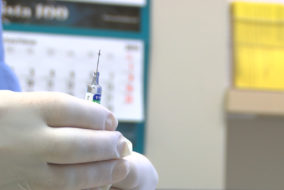Candidiasis is a yeast infection caused by a fungal microorganism, of which Candida albicans is the most common. Candidiasis is also known as thrush and can cause yeast infections in many areas of the body (oral thrush, vaginal thrush, gastroenteritis). It can also be a symptom of a serious disease, such as HIV infection/ AIDS or diabetes. Candida infections may also cause candidemia, which is a systemic and potentially life-threatening condition. It is usually confined to severely immunocompromised people as well as nontrauma emergency surgery patients.
Candida yeasts are generally present in human body, particularly on the skin, but their growth is normally limited by the immune system (by competition of other microorganisms occupying the same locations in the human body). In the case of skin, its relative dryness prevents the growth of fungi. Candida species are also frequently part of the human body’s normal oral and intestinal flora. Treatment with antibiotics (especially prolonged) can lead to eliminating the yeast’s natural competitors for resources.
Diagnosis of a yeast infection is done either via microscopic examination or culturing. The symptoms differ depending on the severity of the infection and the area of the body affected:
• skin candidiasis: itchy skin rash, skin inflammation, small blisters, rash in skin folds;
• oral thrush: white patches inside cheeks, on tongue and/ or in throat;
• vaginal thrush: vaginitis, white flakes, itching, burning, painful urination, painful intercourse, vaginal discharge (thin or thick like cottage cheese; lumpy white discharge), red, swollen and tender vaginal entrance skin.
Candidiasis is commonly treated with antimycotics (antifungal drugs). Most localized cutaneous candidiasis infections may be treated with any number of topical antifungal agents (eg, clotrimazole, econazole, ciclopirox, miconazole, ketoconazole, nystatin). In cases of extensive cutaneous infections, infections in immunocompromised patients, folliculitis, or onychomycosis, systemic antifungal therapy is recommended. Oropharyngeal candidiasis can be treated with either topical antifungal agents or systemic oral azoles. Candida esophagitis requires systemic therapy for 14-21 days. Parenteral antifungal therapy may be required initially if the patient is unable to take oral medications. Vulvovaginal candidiasis can be managed with either topical antifungal agents or a single dose of oral fluconazole. A small percentage (less than 5%) of women experience chronic recurrent vulvovaginal candidiasis infections, which often require long-term or prophylactic oral azole therapy for control.
Glossary
- candidiasis [kændɪˈdaɪəsɪs] – kandydoza
- thrush [θrʌʃ] – pleśniawka
- immunocompromised [ɪmyənoʊˈkɒmprəmaɪzd] – pozbawiony obrony immunologicznej
- blister [ˈblɪstər] – pęcherz
- fold [foʊld] – fałda, zagłębienie
- patch [pætʃ] – plama, łata, miejsce
- flake [fleɪk] – płatek
- intercourse [ˈɪntərkɔrs] – stosunek płciowy
- discharge [ˈdɪstʃɑrdʒ] – wydzielina
- lumpy [ˈlʌmpi] – grudkowaty
- antimycotic [æntɪmaɪˈkɒtɪk] – przeciwgrzybiczy
- antifungal [æntɪˈfʌŋgəl] – przeciwgrzybiczny
- cutaneous [kyuˈteɪniəs] – powierzchniowy, skórny
- folliculitis [fəlɪkyəˈlaɪtɪs] – zapalenie mieszków włosowych
- onychomycosis [ɔnikɔmaɪˈkoʊsɪs] – grzybica paznokci
- vulvovaginal [vʌlvəˈvə`dʒaɪnəl] – dotyczący pochwy i sromu







